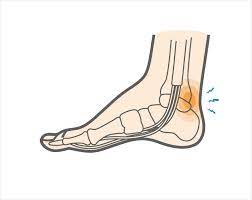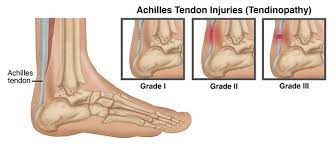Ankle Impingement Physiotherapy
Ankle impingement basically means that there’s something in your ankle that’s pinched (or compressed) with movement.
That’s the simplified version, and this painful condition usually affects people who experience movement forces through their ankle at these “end-range” positions, such as
- cyclists as they pedal
- dancers as they pivot
- gymnasts as they kick off and land on their feet
- soccer players as they dribble and kick the balls
- etc
Of course, it’s not just these people but also people who perform repetitive tasks that involve squatting or stair-climbing are also more at risk to developing ankle impingement too.
Contents
What is ankle impingement?
So there are two types of ankle impingements, which are front (anterior) and back (posterior) of the ankles.
Anterior (front) ankle impingement
The front ankle impingement is the same image as the one we used at the beginning of the article, and the ankle pain that you may experience is typically at the front and/or the front-side of your ankle.
What typically causes this is when there is repeated stress, inflammation and swelling due to activities such as
- jumps
- going down stairs
- squats
- etc
over time, the damage from these activities compound and can lead to bony spurs (bone overgrowth) in the ankle joint space.
Another key reason why anterior ankle impingement happens is due to ankle instability. What I mean by ankle instability is that your ankle is a “little loose” within the ankle joint itself, and this is usually caused by
- joint laxity (looseness)
- repeated ankle sprains that’s untreated
These kind of ankle damage can cause the ligaments of the ankle to thicken due to scarring and cause more swelling, and these both take up more joint space – compressing everything in the already tiny area called the the ankle.
Posterior (back) ankle impingement

Patients with posterior ankle impingement will experience pain and stiffness at the back part of your ankle, and its a lot more obvious when you do stuff that involves pointing your toes. For this condition, the pain is mainly because of the compression of soft or bony tissues between the shin bone (tibia) and the heel bone (calcaneus bone).
Some people have an extra bone in the back of the ankle which is called the os trigonum, and lo and behold, this humble little bone can play a big role in causing posterior ankle impingement because it can cause more compression of the shin and heel bone.
For some others, if they repeatedly have large amount of forces that go through the ankle, that repetitive force can cause a piece of bone to chip off the ankle bone, which can also cause compression when the foot straightens to end of range (imagine moving your toes away from you).
Of course, any form of compression will cause inflammation (which is a normal part of healing) and the process will almost involve pain and swelling.
Common signs and symptoms of ankle impingement
- Pain on the front and/or outside of the ankle joint
- A feeling of ankle instability
- Decreased ankle range of motion when stretching your toes up toward your shin
- Pain at the end-range of stretching your toes toward your shin
- Tenderness at the front of the ankle when touched
Posterior ankle impingement, you may experience:
- Pain on the back of your ankle, especially during activities that involve pointing your toes
- Decreased range of motion when pointing your toes
- Tenderness on the back of the ankle when touched
How is to diagnose ankle impingement?
During your first session, the physiotherapist will ask you
- when your ankle pain symptoms began
- where the location of your ankle pain is in/on/around your ankle
- what types of activities cause your ankle to hurt or to increase its pain
They will also perform a physical examination to evaluate your ankle’s
- strength
- range of motion (ROM)
- sensory / sensation
- structural stability
- balance
We may also get you to do special tests, such as gently moving your ankle to see if it causes symptoms.
We may do specific tests based on your hobbies or interests eg for ballet dancers, we will ask you to do the en pointe tip toe, to see if the form causes the symptoms. Of course, we will also check in with an orthopedic doctor to be extra cautious and definitive in the assessment.
The most accurate method to diagnose ankle impingement is by X-ray or magnetic resonance imaging (MRI), which can be ordered by them.
Physiotherapy for ankle impingement
Your treatment may include:
Pain Management. We may use cold therapy or electrical stimulation, if you have inflammation causing pain. We may ask you to reduce your exercise and activity levels for a while, so the inflammation in your ankle can decrease. We may also use ultrasound therapy and radio-frequency Indiba physiotherapy to accelerate soft tissue healing in your ankle.
Range-of-Motion Exercises. We may gently move your ankle through its available range of motion, or teach you the proper motions to move through in order to increase its mobility and decrease stiffness. If necessary, wet may perform joint mobilizations and manual therapy by skillfully moving the joint in a particular direction to improve its motion.
Muscle-Strengthening Exercises. It is important to strengthen the muscles acting on the foot, ankle, and lower leg to promote proper joint mechanics. When the muscles are strong and working properly, the joint space in the ankle is maintained, which decreases the risk of compression of soft or bony tissues.
Balance Exercises. We may give you balance exercises to challenge the way your body reacts to outside forces. These exercises make you more aware of where your body is in space. Improving your balance will lead to a more stable ankle, because your body can more easily respond to challenges.
Where To Next?
- Go to Home / Start
- Learn and find out more about your pains (bones, muscles, joints, tendons, ligaments, nerves etc) at Pain Conditions & Injuries
- Visit our shop to see products we recommend for pain relief, heating, treatments and more
- Contact us





